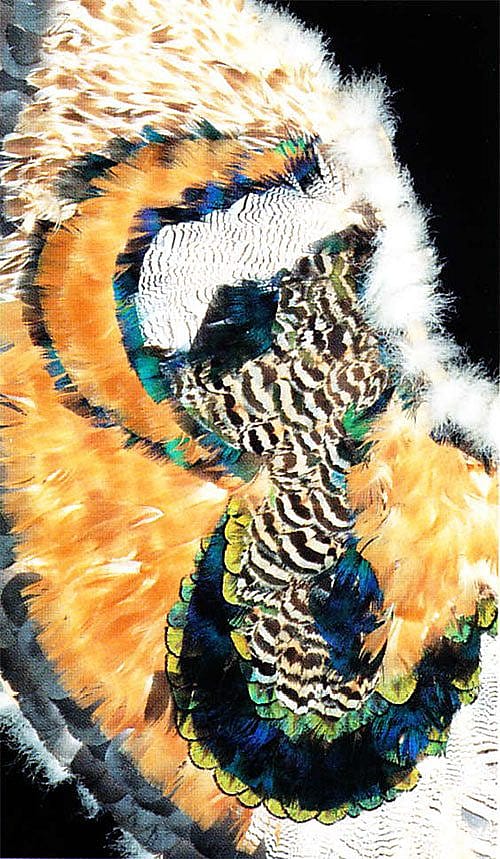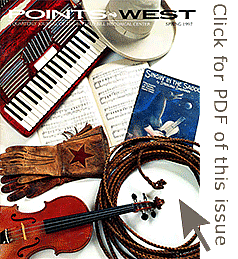The Feathered Cape and Painted Proof – Points West Online
Originally published in Points West magazine
Spring 1997
The Feathered Cape and Painted Proof: Stearns painting resolves mystery on origin of unusual feathered capes
By Emma I. Hansen, Curator Emerita, Plains lndian Museum
and Sarah E. Boehme, Former John S. Bugas Curator, Whitney Western Art Museum
Loans to two different museums in the Center [were] united in a special “focus exhibition” in the CFM Breezeway, opened April 3, 1997. The Plains Indian Museum and the Whitney Gallery of Western Art are cooperating on this display. An unusual feathered cape, made of peacock, peahen, prairie chicken, and guinea fowl feathers from the Great Lakes region and dating from the second quarter of the 19th century [was] loaned to the Plains Indian Museum by Bo and Anna Polk. It [was] exhibited with the painting by Junius Brutus Stearns (1810–1885), Washington and the lndians, 1847, oil on canvas, which [was] on loan from Mr. and Mrs. W.D. Weiss.
![Junius Brutus Stearns (1810-1885). Wcashington and the Indians, 1847, oil on canvas, 36 x 50 inches. Loan from Mr. and Mrs. W.D. Weiss. [now returned to lender; L.77.86.2]](https://centerofthewest.org/cdn-cgi/image/width=800,height=562,fit=crop,quality=80,scq=60,gravity=auto,sharpen=1,metadata=none,format=auto,onerror=redirect/wp-content/uploads/2014/07/PW032_Stearns.jpg)
Approximately 50 feathered capes with similar designs of crescents and inverted triangles exist in museum collections around the world, with 36 in the United States. Without precise collection information, the capes have been attributed in museum records to several cultures ranging from Victorian English to American Indian. Many scholars doubted the American Indian attribution due to the use of peacock feathers, which were not thought to have been available through trade during the early 19th century.
Only one similar cape at the University of lowa Museum of Natural History had a documented collection history. According to museum records, it was made for Mesquakie Chief Poweshiek by his youngest daughter in the winter of 1839. It was subsequently given to Dr. Henry Murray as payment for medical bills for treatment of members of Poweshiek’s family, probably for smallpox. Poweshiek, who was born on the Rock River in Illinois ca. 1790, lived in lowa from about 1836 until removal of the Sauk and Mesquakie to a reservation in Kansas in 1843. Research has shown that peacock feathers, in fact, were available periodically for trade to the Sauk and Mesquakie in the 1830s, and sold for the expensive sum of 25 cents each.
The design of the cape on loan to the museum like those in other collections is strikingly similar in design and technique to that at the University of lowa. According to researchers Nancy Oestreich Lurie and Duane C. Anderson, these interesting feathered capes appear to have been made by a single tribe and distributed among Great Lakes people through trade from the 1820s to the 1850s.
The painting Washington and the Indians attracted the interest of scholars researching the feathered cape because artist Junius Brutus Stearns painted an Indian woman wearing such a cape among the group assembled around George Washington. As the viewer faces the painting, she sits just to the right of Washington with a child at her knee.
Stearns painted this work on commission for the American Art-Union, an organization which distributed works of art to its members through a lottery. He sent the Art-Union a sketch of his proposed painting, which might be the sketch now owned by Mr. and Mrs. W.D. Weiss and also featured in the exhibition. This painting was the first of many that Stearns would paint of the life of Washington, contributing to the glorification of Washington and showing his many roles as soldier, farmer, citizen, statesman, and Christian. (1)
Washington in the Indian Council (alternate title) depicts Washington, on his first mission of diplomatic leadership, at age 21. He met with leaders of the Iroquois Confederacy at Logstown on the Ohio River in 1753. Representing British interests in their conflicts with the French, Washington sought assurances that the Six Nations would continue to be friendly with the British.
Stearns carefully researched the painting and is supposed to have visited Canada and western New York state to study the Indians for this painting. An 1848 publication which commented on the painting noted that it included “portraits of the Onondagas… ” Stearns studied Indian subjects available to him in the 1840s. Having seen one of the feathered capes, he meticulously portrayed it and the other items of Indian clothing, giving his painting the semblance of authenticity. Although the cape would not have been worn in a council in the 18th century, Stearns’ painting supports Lurie and Anderson’s views that the capes were made by lndian women in the nineteenth century.
1. For research on Stearns and his paintings of George Washington, see the writings of Mark Thistlethwaite, especially The lmage of George Washington: Studies in Mid-Nineteenth Century American History Painting (New York, New York: Garland, 1979).
Post 032
Written By
Nancy McClure
Nancy now does Grants & Foundations Relations for the Center of the West's Development Department, but was formerly the Content Producer for the Center's Public Relations Department, where her work included writing and updating website content, publicizing events, copy editing, working with images, and producing the e-newsletter Western Wire. Her current job is seeking and applying for funding from government grants and private foundations. In her spare time, Nancy enjoys photography, reading, flower gardening, and playing the flute.











